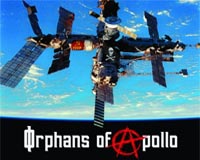 |
Galveston TX (SPX) Jul 30, 2009 When the Apollo 11 crew got back from the moon, 40 years ago this week, they showed no ill effects from seven days spent in weightlessness. But as American astronauts and Soviet cosmonauts began conducting longer-duration space flights, scientists noticed a disturbing trend: the longer humans stay in zero gravity, the more muscle they lose. Space travelers exposed to weightlessness for a year or more - such as those on a mission to Mars, for example - could wind up crippled on their return to Earth, unable to walk or even sit up. Now, researchers at the University of Texas Medical Branch at Galveston have conducted the first human experiments using a device intended to counteract this effect - a NASA centrifuge that spins a test subject with his or her feet outward 30 times a minute, creating an effect similar to standing against a force two and half times that of gravity. Working with volunteers kept in bed for three weeks to simulate zero-gravity conditions, they found that just one hour a day on the centrifuge was sufficient to restore muscle synthesis. "This gives us a potential countermeasure that we might be able to use on extended space flights and solve a lot of the problems with muscle wasting," said UTMB associate professor Douglas Paddon-Jones, senior author of a paper on the centrifuge research in the July issue of the Journal of Applied Physiology. "This small amount of loading, one hour a day of essentially standing up, maintained the potential for muscle growth." Fifteen healthy male volunteers participated in the study, carried out in UTMB's General Clinical Research Center. All spent 21 days lying in a slightly head-down position that previous investigations have shown produces effects on muscles like those of weightlessness. Eight rode the centrifuge daily. Measurements of protein synthesis and breakdown in thigh and calf muscle were taken at the beginning and end of the investigation, using muscle biopsies and blood samples. The results showed that members of the centrifuge group continued to make thigh muscle protein at a normal rate, while the control group's muscle synthesis rate dropped by almost half. Paddon-Jones cautioned that the rate of muscle protein synthesis alone does not necessarily predict changes in muscle function. But, he pointed out, it was still a strong indicator that a relatively brief intervention could have a positive effect in preventing zero-gravity muscle loss - one that might also be applied on Earth. "We've studied elderly inpatients here at UTMB - 95 percent of the time they're completely inactive, and in three days they lose more than a kilogram of muscle," Paddon-Jones said. "A human centrifuge may not be the answer, but we are interested in seeing if something as simple as increasing the amount of time our patients spend standing and moving can slow down this process. This NASA research is one of a series of important studies that we hope to ultimately translate to a clinical population." The other authors of the Journal of Applied Physiology article ("Artificial gravity maintains skeletal muscle protein synthesis during 21 days simulated microgravity") were assistant professor T. Brock Symons, associate professor Melinda Sheffield-Moore, associate professor David L. Chinkes and professor Arny Ferrando. NASA, the National Institutes of Health and UTMB's Claude D. Pepper Older Americans Independence Center provided support for the investigation. Share This Article With Planet Earth
Related Links the missing link Space Tourism, Space Transport and Space Exploration News
 Orphans of Apollo Now Available On DVD
Orphans of Apollo Now Available On DVDLos Angeles, CA (SPX) 13, 2009 Free Radical Productions has now made the documentary film, "Orphans of Apollo," available on DVD @ www.OrphansofApollo.com. "Orphans of Apollo" is the award winning documentary that has been called the "greatest space story never told." The film "Orphans of Apollo," tells the extraordinary true story of a small group of entrepreneurs who felt 'orphaned' by President Nixon's decision to ... read more |
|
| The content herein, unless otherwise known to be public domain, are Copyright 1995-2009 - SpaceDaily. AFP and UPI Wire Stories are copyright Agence France-Presse and United Press International. ESA Portal Reports are copyright European Space Agency. All NASA sourced material is public domain. Additional copyrights may apply in whole or part to other bona fide parties. Advertising does not imply endorsement,agreement or approval of any opinions, statements or information provided by SpaceDaily on any Web page published or hosted by SpaceDaily. Privacy Statement |